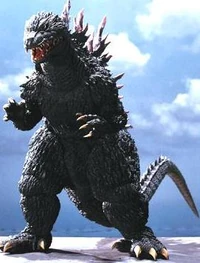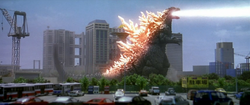Template:Tabber2Millennium Template:Infobox Monster The Godzilla (ゴジラ Gojira?) of the Megaguirus continuity was the second Godzilla within the Millennium series of films. Unlike the 1999 film's Godzilla, this Godzilla is the first and only one within the continuity.
Name
Godzilla's name within the Millennium series follows the convention of that of the Showa era Godzilla, being a transliteration of Gojira (ゴジラ?), a combination of two Japanese words: gorira (ゴリラ?), meaning gorilla, and kujira (鯨 or クジラ?), meaning whale.
Design
GiraGoji
- Main article: Godzilla (G2K)#Appearance.
The appearance of the Megaguirus Godzilla is nearly identical to that of the 1999/2000 Godzilla's. Very few changes were made to this suit design. These included a smaller mouth, flatter face, longer neck, the skin color was changed to an even lighter shade of green, and the color of the dorsal plates was changed to more of a light purple color. This suit is also called the GiraGoji.
Portrayal
The Megaguirus Godzilla would follow in the footsteps of the 1999/2000 Godzilla, being portrayed by suitmation.
Roar
This Godzilla shares the revamped Millennium Godzilla's roar.
Personality
This Godzilla follows the previous Godzilla with regards to attitude and personality, being animalistic in nature. In the end of the film, however, Godzilla become benevolent personality.
Origins
Godzilla vs. Megaguirus features yet another redone origin for the classic monster. The film states that Godzilla simply went back into the ocean after its first attack in 1954, having not been killed by the Oxygen Destroyer as per original canon. It then attacked periodically over the course of the half-century leading to the present day, seemingly feeding on nuclear and plasma energy.
History
Godzilla vs. Megaguirus

In 1954, Godzilla raided Tokyo and reduced the city to a smoldering wasteland in one night. Afterward, Godzilla slipped back into Tokyo Bay and disappeared beneath the waves. The damage was so great that Japan's capital was moved to Osaka. Japan endured a decade of rebuilding, eventually embracing nuclear power and gradually putting Godzilla's attack behind them. But in 1966, Godzilla returned and attacked the Tokai Nuclear Power Plant, feeding on the nuclear reactor. The Japanese government concluded that nuclear power was what attracted Godzilla, so all of the country's nuclear plants were shut down. Japan struggled to find alternate energy sources, but nothing proved able to replace nuclear power. In the 1990's, a breakthrough was made in the form of plasma energy. This clean, non-nuclear power source appeared to be the future of Japanese energy. But in 1996, Godzilla was attracted to the plasma reactor in Osaka, deciding to feed on it in the absence of nuclear energy. A team of J.S.D.F. soldiers were deployed to stop Godzilla, but they were massacred. The lone survivor of the operation was Major Kiriko Tsujimori, who went on to become a founding member of the J.S.D.F.'s elite anti-Godzilla unit, the G-Graspers. By 2001, plasma energy was banned in Japan, and the G-Graspers had developed the ultimate anti-Godzilla weapon, a miniature black hole gun called the Dimension Tide. The Dimension Tide was test-fired in the outskirts of Tokyo, where it completely absorbed an abandoned building. The G-Graspers were certain the Dimension Tide would do the same to Godzilla, and the weapon was mounted on a satellite while the G-Graspers searched for Godzilla. Godzilla was discovered in the waters off Japan, and the GX-813 Griffon was sent to lure him ashore at Kiganjima. The Dimension Tide was prepared and aimed at Godzilla, but suddenly a swarm of giant prehistoric dragonflies called Meganula flew overhead and attacked Godzilla, draining his energy with their tails. Godzilla killed most of the Meganula with his tail and atomic breath, and the Dimension Tide was fired at him. However, the weapon merely buried Godzilla under a pile of rubble, and he quickly got up. Godzilla waded out to sea and vanished.
Shortly afterward, Godzilla came ashore in Tokyo Bay, heading directly for the science institute. En route, he was attacked by Megaguirus, the Meganula queen which had been mutated by the energy her swarm drained from Godzilla. Megaguirus attacked Godzilla near the Tokyo Telecom Center, easily avoiding his attacks and landing several of her own due to her incredible speed. After managing to slice off Megaguirus' claw with his dorsal plates, Godzilla turned the tide of battle when he caught Megaguirus' tail and stuck it into the ground. Godzilla jumped into the air and body-slammed Megaguirus. Megaguirus flew at Godzilla, aiming her stinger at his head, but he caught it in his mouth and bit it off. Megaguirus reeled back in pain, as Godzilla fired his atomic breath directly at her, causing her to erupt in flames before crashing to the ground and exploding. His enemy defeated, Godzilla reached the science institute and uncovered a hidden plasma reactor. While Godzilla was distracted, the Dimension Tide was fired at him. However, the satellite fell out of the atmosphere and was approaching Tokyo. Tsujimori used the Griffon to allow the Dimension Tide to lock on Godzilla's location, then ejected as soon as the weapon fired. When the smoke cleared, Godzilla had disappeared without a trace. Godzilla appeared to be finally gone, and the nation of Japan rejoiced.
A few weeks later though, the G-Graspers began to detect a series of tremors underneath Tokyo, and contemplated the possibility that Godzilla was merely pushed underground by the Dimension Tide like before. They were confirmed when Godzilla emerged and roars from underground in Tokyo. However, unlike before, his roar was benevolent.
Abilities
Atomic breath
Godzilla has his trademark atomic breath within the events of Megaguirus. Much like the 1999 film, Godzilla's atomic breath featured its incendiary properties, on top of being buffed in power, being able to destroy a miniature black hole.
Durability
This incarnation of Godzilla was very durable, being able to survive a black hole at point blank range.
Energy absorption and projection
In the absence of nuclear power in Godzilla vs. Megaguirus, Godzilla seeks out and feeds on plasma energy instead.
Physical abilities
Godzilla features a few distinct abilities in the film, including the ability to jump into the air and bodyslam his airborne opponent. Godzilla's tail was revealed to be prehensile within the events of the film.
Godzilla also showed the ability to use his dorsal plates as a weapon, when he uses their jagged tips to slice off Megaguirus' claw. In addition, the dorsal plates create a tremendous amount of heat when the atomic breath is being prepared.
Anti-Godzilla weaponry
Dimension Tide
The Dimension Tide was introduced as a weapon within the events of the film, being a weapon capable of firing a black hole. A black hole was fired at Godzilla as the craft begun to crash land back to Earth. Godzilla countered the black hole with a blast of atomic breath, which resulted in an explosion, with Godzilla vanishing as the smoke cleared, having been seemingly killed by the weapon. He was later revealed to have survived, however, the weapon was effective in at least subduing him for a few days.
Video games
Godzilla (2014 video game)
Like the 1999 Godzilla, this incarnation wasn't a playable monster within the 2014 Godzilla game, however, it was briefly mentioned within the game's Kaiju Guide alongside the other Millennium Godzillas.
List of appearances
Films
- Godzilla vs. Megaguirus (First appearance)
Video games
- Godzilla (2014 video game) (Kaiju Guide mention)
References
Template:FilmKaijuNavbox

